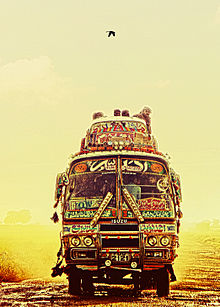
Culture and society
Culture and society
Main articles: British heritage of Pakistan, Culture of Pakistan, and Public holidays in Pakistan

Truck art in Pakistan is a unique feature of Pakistani culture.
Civil society in Pakistan is largely hierarchical, emphasising local cultural etiquettes and traditional Islamic values that govern personal and political life. The basic family unit is the extended family, although there has been a growing trend towards nuclear families for socio-economic reasons. The traditional dress for both men and women is the Shalwar Kameez; trousers, Jeans, and shirts are also popular among men. The middle class has increased to around 35 million and the upper and upper-middle classes to around 17 million in recent decades, and power is shifting from rural landowners to the urbanised elites. Pakistani festivals such as Eid-ul-Fitr, Eid-ul-Azha, Ramazan, Christmas, Easter, Holi, and Diwali are mostly religious in origin. Increasing globalisation has resulted in Pakistan ranking 56th on the A.T. Kearney/FP Globalization Index.
Clothing, arts, and fashion
Main articles: Suits in Pakistan, Pakistani clothing, Sherwani, Jinnah cap, and Peshawari chappal
The Shalwar Kameez is the national dress of Pakistan and is worn by both men and women in all four provinces: Punjab, Sindh, Balochistan, and Khyber-Pakhtunkhwa as well as in FATA and Azad Kashmir. Each province has its own style of wearing the Shalwar Kameez. Pakistanis wear clothes range from exquisite colors and designs to the type of fabric (silk, chiffon, cotton, etc). Besides the national dress, the domestically tailored suits and neckties are often and usually worn by men in the country, and it is customary in offices, schools, and other necessary places and popular gatherings.
The fashion industry has flourished well in the changing environment of the fashion world. Since Pakistan came into being, its fashion has historically evolved from different phases and made its unique identity apart from Indian fashion and culture. At this time, Pakistani fashion is a combination of traditional and modern dresses and it has become the cultural identification of Pakistan. Despite all modern trends, the regional and traditional dresses have developed their own significance as a symbol of native tradition. This regional fashion is not static but evolving into more modern and pure forms. The Pakistan Fashion Design Council based in Lahore organizes Fashion Week and Fashion Pakistan based in Karachi organizes fashion shows in that city. Pakistan’s first fashion week was held in November 2009.
Categories: Culture & Tradition
